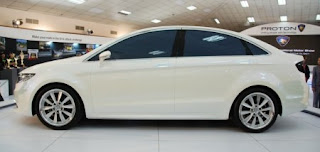Ahead of the Kuala Lumpur International Motor Show’s opening, Proton and Universiti Teknologi Malaysia today previewed the EV Saga plug-in electric vehicle, a collaborative effort that took 11 months to develop.
In case you’re wondering whether this is the same Saga EV Concept as seen more than a year ago, well, it’s not, even if you can’t run away from some of the EV-based fundamentals and the similar name – the current car also bears the Green Propulsion Concept sub-moniker the earlier version did.
The project had a core team of 20 people, 10 each from Proton and UTM, with the UTM team made up of lecturers, postgrad student and technicians from the university’s Power Electronics and Drives Research Group (PEDG) of the Energy Research Alliance, led by associate professor Dr Nik Rumzi Nik Idris.
Effectively, Proton laid the foundations with a base Saga, sans standard drivetrain and powertrain, and specified – as well as purchased – the EV-based materials that were used on the car, with UTM primarily responsible for incorporating everything into developing the final product. The modification work was done at the FKE lab in Skudai, Johor and at Proton’s Research Dept lab in Shah Alam.
Specifications-wise, the EV Saga fields an Azure Dynamics AC24LS 5.5 kW 4-pole, three-phase air-cooled AC electric motor (and corresponding DMOC445 digital motor controller) that can spin up to a maximum of 11,000 rpm, and which offers 47 kW (63 hp) of peak power and 92 Nm of max torque, working with a single-gear transmission and a 15 kWh, 50Ah lithium-ion battery.
The battery consists of 8 separate modules, and each module is made up of 40 cells (in a four-in-parallel, 10-in-series configuration), and together the assembly weighs in at 240 kg, though unlike the 12 module battery in the earlier Saga EV incarnation, it doesn’t completely eat up the boot space of the car (they sit quite comfortably in the spare wheel well area). Incidentally, weight-wise, the EV Saga tips the scales at just 150 kg more than a standard Saga, with the battery being the hefty lad.
The battery gets its cooling via fan ventilation, which gets its juice from the three-panel solar photovoltaic system sitting on the roof of the car. Each panel is able to provide 5 watts, making 15 in total, just enough to get things going for the battery, but not enough to ventilate the cabin – the incorporation of a larger panel assembly is being planned.
Off a normal 240V point, the battery takes seven to eight hours to charge fully, though it can be fast charged if the need arises. Performance-wise, the EV Saga has a top speed of 125 kph and offers a 160 km range (in NEDC cycle mode), with a 0-100 kph time of 14.5 seconds.
The gearshift in the prototype had a rather strange selector pattern arrangement (D, B, P, N, S, E, R), which turned out to be Drive, (regenerative) Braking, Park, Neutral, Sport, Eco and Reverse. Well, the Sport (full power) and Eco (the term is descriptive enough, no?) functions had to go somewhere, I suppose. A switch marked Regen Brake (with either Dry or Slippery mode, toggled) next to the shifter is essentially an adjustment switch for the level of regeneration being placed back into the system.
There are some points to note about the performance figures above, as I found out from talking to the UTM boffins – the top speed is that read from bench testing, and though the range under the NEDC cycle is rated at 160 km, testing under real world conditions (with traffic, as well as irregular stop-start and speed cycles) hasn’t ascertained what a realistic – and repeatable – operational range might be. So far, on-road testing has been primarily carried out within UTM’s grounds. And though the car has an air-conditioner, the latter hasn’t been factored in too.

Final numbers notwithstanding, the effort is a sterling one from those involved in the EV’s development. As with all things new, the learning curve has been steep; the project has had its odd hiccup and expected difficulties while in transition from start to final product (the nastiest bit would be an incident during DC to DC testing, with an oversight effectively frying half the battery assembly’s modules). Still, there has certainly been much learnt, and learnt very well, so kudos are in order – take a bow, gentlemen.
A mention of another highlight in the EV Saga, which revolves around the lights. The car features the use of LED head and tail lamps, which isn’t exactly novel, but what is happens to be the system that drives things along – a specially-designed digital optics driver made by Penang-based company Digitron Research Laboratory.
The system, which took two years to design, offers tunable and efficiently distributed light intensity and throw (up to 20 metres), with items such as phase and time shift as well as line vectoring all tailorable, depending on application.
Beneficially, in the EV Saga, the two headlamps use up only 12 watts of consumption, the tail lamp cluster 10 watts, and the interior lighting a further eight watts, making for a grand total of 30. Which follows the green stance of things to a T. Its developer says the real benefits of the system will be in the area of commercial lighting, which is definitely a very bright thought.

 Total Episodes: 16
Total Episodes: 16




























